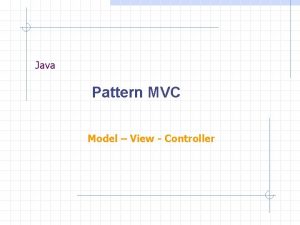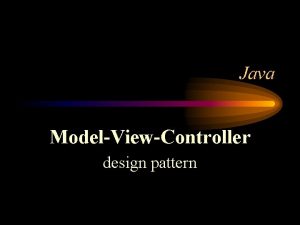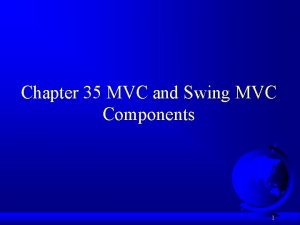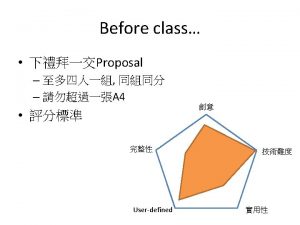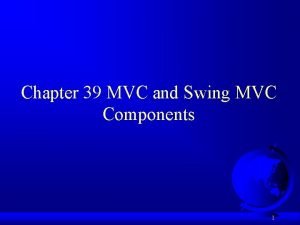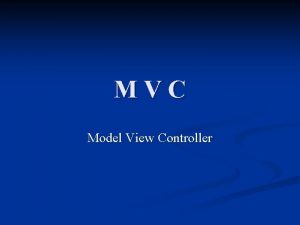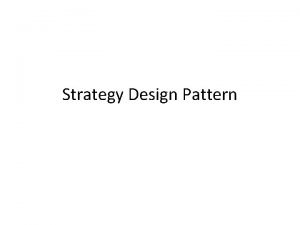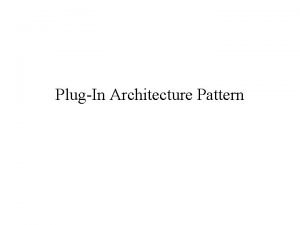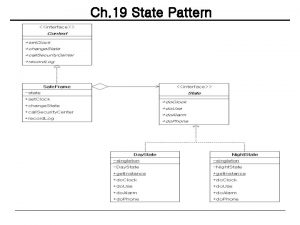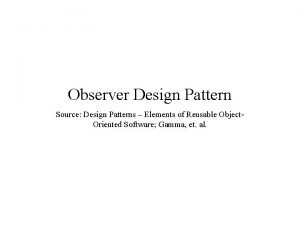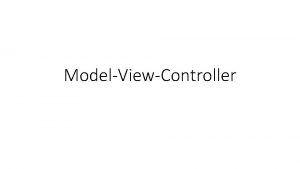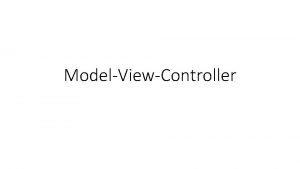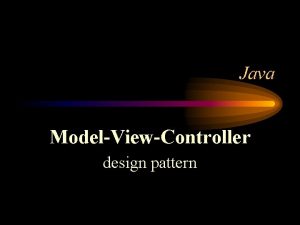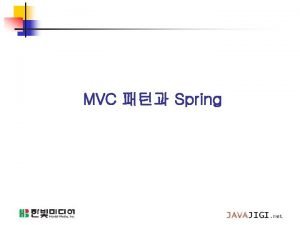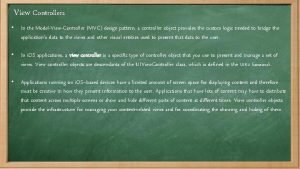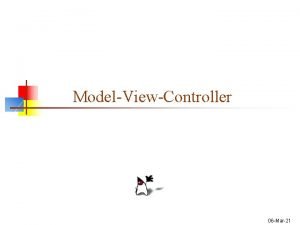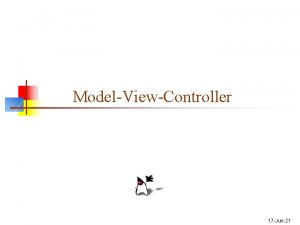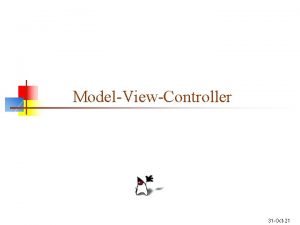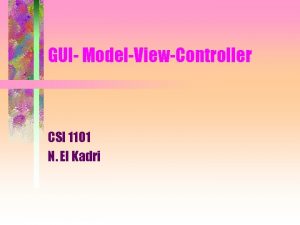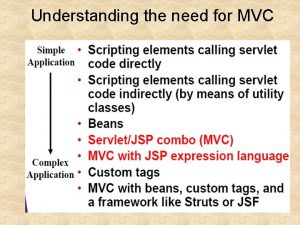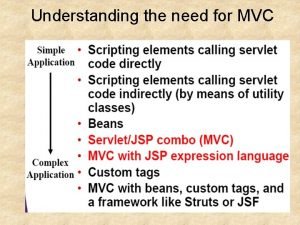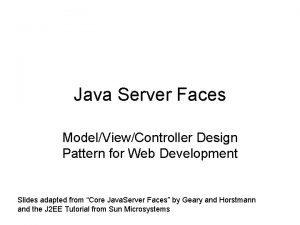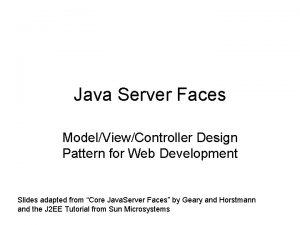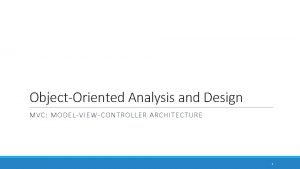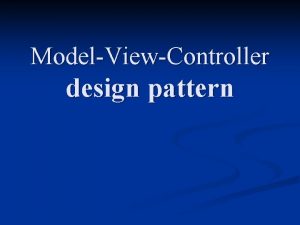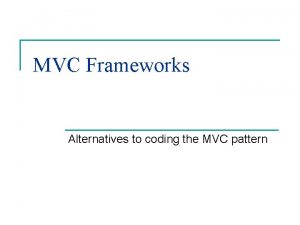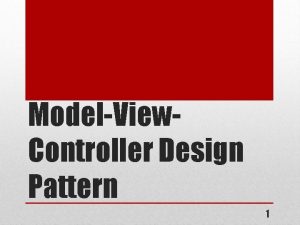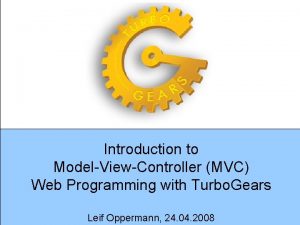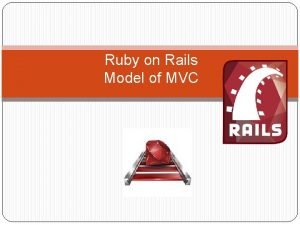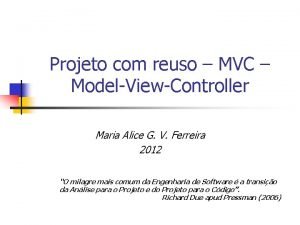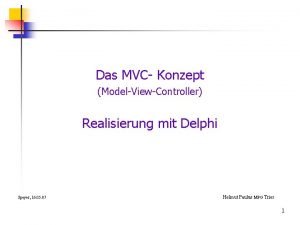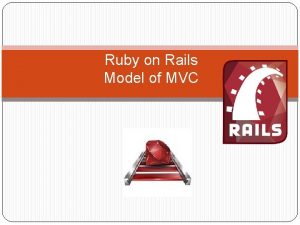Java ModelViewController design pattern The MVC pattern MVC































- Slides: 31

Java Model-View-Controller design pattern

The MVC pattern • MVC stands for Model-View-Controller • The Model is the actual internal representation • The View (or a View) is a way of looking at or displaying the model • The Controller provides for user input and modification

View Model Controller

View Model Controller The Model • Most programs are supposed to do work, not just be "another pretty face" – but there are some exceptions – useful programs existed long before GUIs • The Model is the part that does the work • The Model should be independent of the GUI • Independence gives flexibility, robustness

View Model Controller The Controller • A GUI lets the user control what work the program is doing • The design of the GUI depends on the Model. . . • . . . but the Model should not depend on the GUI • Unless the Model (what the program does) is the GUI, these can always be separated • Java's controls are Buttons, Text. Fields, etc.

View Model Controller The View • The user has to be able to see, or view, what the program is doing • The Model should be independent of the View (but it can provide access methods) • The View should not display what the Controller thinks is happening

Model View Controller Combining the Controller and View • Sometimes the Controller and View are combined, especially in small programs • Combining the Controller and View is appropriate if they are very interdependent • The Model should still be independent • Never mix Model code with GUI code!

Separation of concerns • As always, you want code independence • The Model should not be contaminated with control code or display code • The View should represent the Model as it really is, not some remembered status • The Controller should talk to the Model and View, not manipulate them

The Bouncing Ball Applet • Each click of the Step button advances the ball a small amount • The step number and ball position are displayed in the status line

The Ball Applet: Model • The Ball Applet shows a ball bouncing in a window • The Model controls the motion of the ball • To know when to bounce, the Model must know the size of the window • The Model doesn’t need to know anything else about the GUI

Sample CRC index card Class Name Responsibilities. . Collaborators. .

Model • Set initial position • Move one step • No collaborators. . . • …but allow access from View

Model I class Model { final int BALL_SIZE = 20; int x. Position = 0; int y. Position = 0; int x. Limit, y. Limit; int x. Delta = 6; int y. Delta = 4; // more. . .

Model II void make. One. Step ( ) { x. Position += x. Delta; if (x. Position < 0) { x. Position = 0; x. Delta = -x. Delta; } // more. . .

Model III if (x. Position >= x. Limit) { x. Position = x. Limit; x. Delta = -x. Delta; } // still more. . .

Model IV y. Position += y. Delta; if (y. Position < 0 || y. Position >= y. Limit) { y. Delta = -y. Delta; y. Position += y. Delta; } } // end of make. One. Step method } // end of Model class

Model (repeated) Model • Set initial position • Move one step • No collaborators. . . • …but allow access from View

The Ball Applet: View • The View needs access to the ball’s state (in this case, it’s x-y location) • For a static drawing, the View doesn’t need to know anything else

View • Paint the ball • Access Model

View I class View extends Canvas { Controller controller; Model model; int step. Number = 0; // more. . .

View II public void paint (Graphics g) { g. set. Color (Color. red); g. fill. Oval (model. x. Position, model. y. Position, model. BALL_SIZE); controller. show. Status ("Step " + (step. Number++) + ", x = " + model. x. Position + ", y = " + model. y. Position); } // end paint method

View (repeated) View • Paint the ball • Access Model

The Ball Applet: Controller • The Controller tells the Model what to do • The Controller tells the View when it needs to refresh the display • The Controller doesn’t need to know the inner workings of the Model • The Controller doesn’t need to know the inner workings of the View

Controller • Create Model • Create View • Give View access to Model • Tell Model to advance • Tell View to repaint • Model • View

import java. applet. *; import java. awt. event. *; Controller I public class Controller extends Applet { Panel button. Panel = new Panel (); Button step. Button = new Button ("Step"); Model model = new Model (); View view = new View (); // more. . .

Controller II public void init () { // Lay out components set. Layout (new Border. Layout ()); button. Panel. add (step. Button); this. add (Border. Layout. SOUTH, button. Panel); this. add (Border. Layout. CENTER, view); // more. . .

Controller III // Attach actions to components step. Button. add. Action. Listener (new Action. Listener () { public void action. Performed (Action. Event event) { model. make. One. Step (); view. repaint (); }}); // more. . .

Controller IV // Tell the View about myself (Controller) and // about the Model view. model = model; view. controller = this; } // end init method // more. . .

Controller V public void start ( ) { model. x. Limit = view. get. Size ( ). width - model. BALL_SIZE; model. y. Limit = view. get. Size ( ). height - model. BALL_SIZE; repaint (); } // end of start method } // end of Controller class

Controller (repeated) Controller • Create Model • Create View • Give View access to Model • Tell Model to advance • Tell View to repaint • Model • View

The End
 Pattern mvc java
Pattern mvc java паттерн mvc java
паттерн mvc java Swing mvc example
Swing mvc example Yoshi
Yoshi Java swing mvc example
Java swing mvc example Boundary control entity
Boundary control entity Strategy design pattern
Strategy design pattern Plugin design pattern java
Plugin design pattern java Abstract factory design pattern
Abstract factory design pattern State design pattern java
State design pattern java Java observer design pattern
Java observer design pattern Memento design pattern java
Memento design pattern java Hình ảnh bộ gõ cơ thể búng tay
Hình ảnh bộ gõ cơ thể búng tay Bổ thể
Bổ thể Tỉ lệ cơ thể trẻ em
Tỉ lệ cơ thể trẻ em Gấu đi như thế nào
Gấu đi như thế nào Tư thế worm breton
Tư thế worm breton Hát lên người ơi
Hát lên người ơi Các môn thể thao bắt đầu bằng tiếng bóng
Các môn thể thao bắt đầu bằng tiếng bóng Thế nào là hệ số cao nhất
Thế nào là hệ số cao nhất Các châu lục và đại dương trên thế giới
Các châu lục và đại dương trên thế giới Công của trọng lực
Công của trọng lực Trời xanh đây là của chúng ta thể thơ
Trời xanh đây là của chúng ta thể thơ Mật thư tọa độ 5x5
Mật thư tọa độ 5x5 101012 bằng
101012 bằng độ dài liên kết
độ dài liên kết Các châu lục và đại dương trên thế giới
Các châu lục và đại dương trên thế giới Thơ thất ngôn tứ tuyệt đường luật
Thơ thất ngôn tứ tuyệt đường luật Quá trình desamine hóa có thể tạo ra
Quá trình desamine hóa có thể tạo ra Một số thể thơ truyền thống
Một số thể thơ truyền thống Cái miệng xinh xinh thế chỉ nói điều hay thôi
Cái miệng xinh xinh thế chỉ nói điều hay thôi
